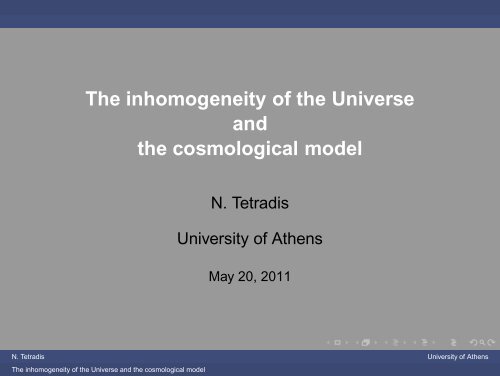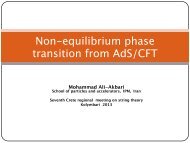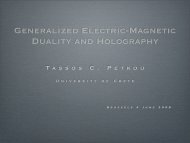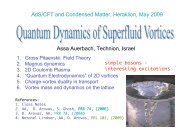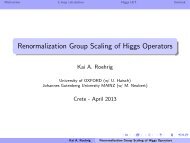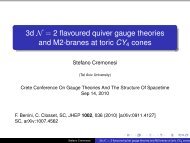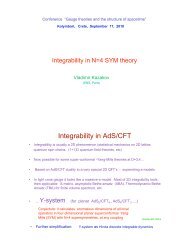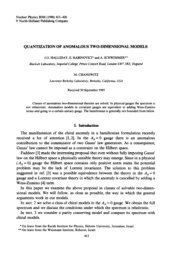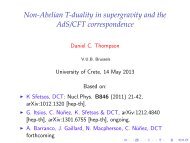Nikolaos Tetradis
Nikolaos Tetradis
Nikolaos Tetradis
You also want an ePaper? Increase the reach of your titles
YUMPU automatically turns print PDFs into web optimized ePapers that Google loves.
Figure: 2MASS Galaxy Catalog (more than 1.5 million galaxies).N. <strong>Tetradis</strong> University of AthensThe inhomogeneity of the Universe and the cosmological model
OutlineEffect of inhomogeneities on the average expansionA similar problem in brane cosmologyLarge-scale structures in quintessence cosmologyNon-linear spectrum of matter perturbations1 Coupled quintessence2 Variable equation of state3 Growing neutrino quintessenceConclusionsN. <strong>Tetradis</strong> University of AthensThe inhomogeneity of the Universe and the cosmological model
Standard frameworkBasic assumptions: Homogeneity and isotropyds 2 = −dt 2 + a 2 (t)δ ij dx i dx j(ȧ ) 2= 8πGa 3 ρäa = − 4πG (ρ + 3p)3Inhomogeneities can be treated as small perturbations of thisbackgroundIndications for the acceleration of the cosmological expansion1 Distant supernovae2 Power spectrum of the galaxy distribution3 Cosmic microwave backgroundFor acceleration: p < −ρ/3N. <strong>Tetradis</strong> University of AthensThe inhomogeneity of the Universe and the cosmological model
QuestionAssumed, but not observed directly, dominant contributions tothe energy content of the Universe:1 Dark matter: p = 0 (∼ 25%)2 Dark energy: p < 0 (∼ 70%)Could the acceleration of the cosmological expansion be relatedto the appearance of inhomogeneities in a pressurelesscosmological fluid (dark matter)?N. <strong>Tetradis</strong> University of AthensThe inhomogeneity of the Universe and the cosmological model
Our approachAll the information about the expansion of the Universe isobtained through light signals.Study light propagation in an exact background that mimics aUniverse with structure.Calculate observables: Luminosity distance of a light source afunction of its redshift.P. Apostolopoulos, N. Brouzakis, N. T., E. Tzavaraastro-ph/0603234, JCAP 0606: 009 (2006)N. Brouzakis, N. T., E. Tzavaraastro-ph/0612179, JCAP 0702: 013 (2007)astro-ph/0703586, JCAP 0804: 008 (2008)N. Brouzakis, N. T.arXiv:0802.0859 [astro-ph], Phys. Lett. B 665: 344-348 (2008)N. <strong>Tetradis</strong> University of AthensThe inhomogeneity of the Universe and the cosmological model
3.02.5(t,r)/ FRW(t)2.01.51.00.50.7 0.8 0.9 1.0 1.1R(t,r)/R(t,1)Figure: The evolution of the density profile for a central underdensitysurrounded by an overdensity.N. <strong>Tetradis</strong> University of AthensThe inhomogeneity of the Universe and the cosmological model
Luminosity distance and redshiftConsider photons emitted within a solid angle Ω s by an isotropicsource with luminosity L. These photons are detected by anobserver for whom the light beam has a cross-section A o .The redshift factor is1 + z = ω s= k s0ω o ko0 ,The energy flux f o measured by the observer isf o =L4πD 2 L= L Ω s4π (1 + z) 2 .A oIntegrating the Sachs optical equations allows the determinationof the luminosity distance D L as a function of the redshift z.N. <strong>Tetradis</strong> University of AthensThe inhomogeneity of the Universe and the cosmological model
Observer at the center of a large holeFigure: The distance modulus µ = m − M = 5 log(D L /Mpc) + 25 as afunction of redshift z.a) Green line: FRW cosmology with Ω m = 1, Ω Λ = 0.b) Blue line: FRW cosmology with Ω m = 0.3, Ω Λ = 0.7.c) Red line: LTB cosmology with the observer at the center of an underdenseregion of present size ∼ 800 Mpc.N. <strong>Tetradis</strong> University of AthensThe inhomogeneity of the Universe and the cosmological model
Observer and source at random positionsProbability DensityProbability Density2402001601208040024020016012080400z=0.5-0.01 0.00 0.01z=1.5-0.01 0.00 0.01Probability DensityProbability Density24020016012080400240200z=1-0.01 0.00 0.01D L/D L, FRW-0.01 0.01160 z=21208040D L/D L, FRW00.00D L/D L, FRWD L/D L, FRWFigure: The distribution of luminosity distances for various redshifts in theLTB Swiss-cheese model for inhomogeneities with length scale 40 h −1 Mpc.N. <strong>Tetradis</strong> University of AthensThe inhomogeneity of the Universe and the cosmological model
Probability Density100806040200z=0.5-0.04 -0.02 0.00 0.02Probability Density100806040200z=1-0.04 -0.02 0.00 0.02D L/D L, FRWD L/D L, FRWProbability Density100806040200z=1.5-0.04 -0.02 0.00 0.02Probability Density100806040200z=2-0.04 -0.02 0.00 0.02D L/D L, FRWD L/D L, FRWFigure: Same as before for a characteristic scale of 400 h −1 Mpc.N. <strong>Tetradis</strong> University of AthensThe inhomogeneity of the Universe and the cosmological model
A similar problem in brane cosmologyIdentify the Universe with a hypersurface (brane) infive-dimensional space-time. Low-energy gravity is localizednear the brane (Randall, Sundrum (1999)).Assume an inhomogeneous energy distribution along the fourthspatial dimension. Is accelerated expansion possible along thebrane?For an arbitrary energy distribution, accelerated expansionrequires negative pressure either on the brane or in the bulk.This holds even when corrections, such as an induced gravityterm on the brane, or a Gauss-Bonnet term in the bulk, are takeninto account.P. Apostolopoulos, N. T.astro-ph/0604014, Phys. Rev. D 74: 064021 (2006)P. Apostolopoulos, N. Brouzakis, N. T., E. TzavaraarXiv:0708.0469, Phys. Rev. D 76: 084029 (2007)N. <strong>Tetradis</strong> University of AthensThe inhomogeneity of the Universe and the cosmological model
Quintessence cosmologyIt seem unlikely that the acceleration of the cosmologicalexpansion can be attributed to the growth of inhomogeneities.Negative pressure is needed.The simplest scenario assumes the presence of a cosmologicalconstant.The quintessence scenario attempts to provide a dynamicalexplanation for the smallness of the present value of the vacuumenergy.We shall discuss coupled quintessence: a quintessence fieldcoupled with dark matter (or neutrinos).What kind of new structures can appear in such cosmologies?Are they observable?N. <strong>Tetradis</strong> University of AthensThe inhomogeneity of the Universe and the cosmological model
Basic relationsAction∫S =d 4 x √ ( 1−g16πG R − 1 ∂φ ∂φ2 ∂x µ)− U(φ)∂x µ− ∑ i∫m(φ(x i ))dτ i ,with dτ i = √ −g µν (x i )dx µparticle trajectories.Equation of motionidxiνand the second integral taken over(1 ∂ √−g√ gµν ∂φ )−g ∂x µ ∂x ν = dU d ln m(φ(x))−dφ dφ(T M ) µ µ .N. <strong>Tetradis</strong> University of AthensThe inhomogeneity of the Universe and the cosmological model
Cosmological evolutionHomogeneous background¨φ + 3H ˙φ = dU d ln m(φ)+ (ρ − 3p)dφ dφd ln m(φ)˙ρ + 3Hρ = − (ρ − 3p)dφ˙φH 2 = 8πG ( 13 2 ˙φ 2 + U(φ) + ρ)N. <strong>Tetradis</strong> University of AthensThe inhomogeneity of the Universe and the cosmological model
Static spherically symmetric configurationsMetric:ds 2 = −B(r)dt 2 + r 2 (dθ 2 + sin 2 θ dφ 2 ) + A(r)dr 2 .Fermi-Dirac distribution at every point in space:[ (√ ) −1p2 + mf(p) = exp2 (φ(r)) − µ(r)+ 1].T(r)The Einstein equations give:T(r) = T 0 / √ B(r),µ(r) = µ 0 / √ B(r).N. T.hep-ph/0507288, Phys. Lett. B 632: 463-466 (2006)N. Brouzakis, N. T.astro-ph/0509755, JCAP 0601: 004 (2006)N. T., J.D. Vergados, A. Faesslerhep-ph/0609078, Phys. Rev. D 75: 023504 (2007)N. <strong>Tetradis</strong> University of AthensThe inhomogeneity of the Universe and the cosmological model
Dark matter in galaxy haloesThe coupling between DM and the quintessence field generatesan attractive force between DM particles.The typical DM velocity is larger than in the decoupled case.Implications for DM detection.N. <strong>Tetradis</strong> University of AthensThe inhomogeneity of the Universe and the cosmological model
Compact astrophysical objects made of dark matter1.41.21.00.80.60.40.20.00 50 100 150 200 250 300rAB10 3 pFigure: A typical configurationN. <strong>Tetradis</strong> University of AthensThe inhomogeneity of the Universe and the cosmological model
M tot(M )/M=1, /GeV=13.0 11/M=1, /GeV=3/22.5 1/M=3/2, /GeV=2/31/M=3/2, /GeV=12.01.51.00.50.00 5 10 15 20R(km)Figure: The mass to radius relation.N. <strong>Tetradis</strong> University of AthensThe inhomogeneity of the Universe and the cosmological model
Astrophysical objects made of neutrinosR(Mpc)1000I: R=2,~| =0.2~100I: R=0.65, | =0.05I: R=5.4~10 -4 , =10 -41010.10.011E-31E-4 II: R=0.54,~=10 -5~1E-5II: R=0.054, | =10 -70.1 1 10 100m (eV)N. Brouzakis, N. T., C. Wetteriche-Print: arXiv:0711.2226 [astro-ph] , Phys. Lett. B 665: 131 (2008)N. <strong>Tetradis</strong> University of AthensThe inhomogeneity of the Universe and the cosmological model
Link with observationsStudy the formation of structure in the distribution of dark (andbaryonic) matter.Dark energy does not cluster.The evolution of inhomogeneities depends on the cosmologicalbackground.The matter spectrum at various redshifts reflects the detailedstructure of the cosmological model.Comparison with observations of the galaxy distribution candifferentiate between models.Baryon acoustic oscillations: 100 Mpc range.Analytical calculation of the matter spectrum beyond the linearlevel. Crocce, Scoccimarro (2005)N. <strong>Tetradis</strong> University of AthensThe inhomogeneity of the Universe and the cosmological model
Sloan Digital Sky Survey (2005)Figure: Galaxy correlation function.N. <strong>Tetradis</strong> University of AthensThe inhomogeneity of the Universe and the cosmological model
Formalism: Time renormalization group (Pietroni 2008)Action for quintessence and non-relativistic fluid∫S = d 4 x √ ( 1−g2M 2 R − 1 )∂φ ∂φ2 ∂x µ − U(φ) − ∑ ∂x µi∫m(φ(x i ))dτ i ,with dτ i = √ −g µν (x i )dx µparticle trajectories.Equation of motionidxiνand the second integral taken over(1 ∂ √−g√ gµν ∂φ )−g ∂x µ ∂x ν = dU d ln m(φ(x))−dφ dφM = 1β(φ) = −d ln m(φ)/dφ.(T CDM ) µ µ .N. <strong>Tetradis</strong> University of AthensThe inhomogeneity of the Universe and the cosmological model
Ansatz for the metricds 2 = a 2 (τ) [ (1 + 2Φ(τ,⃗x)) dτ 2 − (1 − 2Φ(τ,⃗x)) d⃗x d⃗x ] ,with Φ ≪ 1.Scalar fieldφ(τ,⃗x) = ¯φ(τ) + δφ(τ,⃗x),with δφ/¯φ ≪ 1. In general, ¯φ = O(1) in units of M.Density fieldρ(τ,⃗x) = ¯ρ(τ) + δρ(τ,⃗x),with δρ/¯ρ < ∼ 1.Velocity field|δ⃗v| ≪ 1.N. <strong>Tetradis</strong> University of AthensThe inhomogeneity of the Universe and the cosmological model
Hierarchy of scalesFor subhorizon perturbations with momenta k ≫ H = ȧ/a, thelinear analysis predicts |δ⃗v| ∼ (k/H)Φ ∼ (H/k)(δρ/¯ρ).We assume the hierarchy of scales: Φ, δφ/¯φ ≪ |δ⃗v| ≪ δρ/¯ρ 1.As we are dealing with subhorizon perturbations, we assumethat the spatial derivatives of Φ, δφ, δ⃗v dominate over their timederivatives. We also assume that a spatial derivative acting on Φ,δφ or δ⃗v increases the position of that quantity in the hierarchy byone level: ⃗ ∇Φ is comparable to Hδ⃗v, while ∇ 2 Φ is comparable toH 2 δρ/¯ρ.F. Saracco, M. Pietroni, N. T., V. Pettorino, G. RobbersarXiv:0911.5396[astro-ph], Phys. Rev. D 82: 023528 (2010)N. <strong>Tetradis</strong> University of AthensThe inhomogeneity of the Universe and the cosmological model
Equations of motion for several non-relativistic speciesThe evolution of the homogeneous background is described byH 2 = 1 [ ∑a2¯ρ i + 1 ˙¯φ 2 + a 2 U(¯φ) ] ≡ 1 323 a2 ρ toti=1,2˙¯ρ i + 3H¯ρ i = − β i˙¯φ¯ρi⎛¨¯φ + 2H ˙¯φ = − a2⎝ dUdφ (¯φ) − ∑with ρ tot ≡ ∑ i¯ρ i + ˙¯φ2 /(2a 2 ) + U(¯φ).i=1,2β i ¯ρ i⎞⎠,For the CDM we set β 1 = β, while for BM, because of strongobservational constraints , we set β 2 = 0.N. <strong>Tetradis</strong> University of AthensThe inhomogeneity of the Universe and the cosmological model
Equations for the perturbationsPoisson equations∇ 2 δφ = − a 2 ∑ iβ i δρ i ≡ −3 ∑ iβ i H 2 Ω i δ i∇ 2 Φ = 1 2 a2∑ iδρ i ≡ 3 2 H2 ∑ iΩ i δ i ,with Ω i (τ) ≡ ¯ρ i a 2 /(3H 2 ).Continuity and Euler equationsδ ˙ρ i + 3Hδρ i + ∇[(¯ρ ⃗ i + δρ i )δ⃗v i ] = − β i˙¯φδρiδ ˙⃗v i + (H − β i˙¯φ)δ⃗vi + (δ⃗v i · ⃗∇)δ⃗v i = − ∇Φ ⃗ + β i∇δφ.⃗N. <strong>Tetradis</strong> University of AthensThe inhomogeneity of the Universe and the cosmological model
Time renormalization group (Pietroni (2008))Fourier-transformed density contrast and velocity field:δ i ≡ δρ i (k, τ)/¯ρ i and θ i (k, τ) ≡ ∇ ⃗ · δv ⃗ i (k, τ).They obey∫˙δ i (k, τ)+θ i (k, τ) = − d 3 k 1 d 3 k 2 δ D (k−k 1 −k 2 ) ˜α(k 1 , k 2 )θ i (k 1 , τ)δ i (k 2 , τwhere ˜α(k 1 , k 2 ) = k 1 · (k 1 + k 2 )/k 2 1 , and∑˙θ i (k, τ)+(H − β i˙¯φ)θi (k, τ) + 3H2 j Ω j(2β i β j + 1)δ j (k, τ)∫2= − d 3 k 1 d 3 k 2 δ D (k − k 1 − k 2 ) ˜β(k 1 , k 2 )θ i (k 1 , τ)θ i (k 2 , τ),where ˜β(k 1 , k 2 ) = (k 1 + k 2 ) 2 k 1 · k 2 /(2k 2 1 k 2 2 ).N. <strong>Tetradis</strong> University of AthensThe inhomogeneity of the Universe and the cosmological model
Define the quadruplet⎛⎛ ⎞ϕ 1 (k, η)ϕ 2 (k, η)= e −η ⎜ ϕ 3 (k, η)⎟⎝ ⎠⎜⎝ϕ 4 (k, η)where η = ln a(τ).The equations of motion becomeδ CDM (k, η)− θ CDM(k, η)Hδ BM (k, η)− θ BM(k, η)H⎞,⎟⎠∂ η ϕ a (k, η) + Ω ab ϕ b (k, η) = e η γ abc (k, −k 1 , −k 2 )ϕ b (k 1 , η)ϕ c (k 2 , η).The indices a, b, c take values 1, . . .,4. Repeated momenta areintegrated over, while repeated indices are summed over.N. <strong>Tetradis</strong> University of AthensThe inhomogeneity of the Universe and the cosmological model
The non-zero components of the effective vertices γ areγ 121 (k, k 1 , k 2 ) = ˜α(k 1, k 2 )δ D (k + k 1 + k 2 ) = γ 112 (k, k 2 , k 1 )2γ 222 (k, k 1 , k 2 ) = ˜β(k 1 , k 2 ) δ D (k + k 1 + k 2 )γ 343 (k, k 3 , k 4 ) = ˜α(k 3, k 4 )δ D (k + k 3 + k 4 ) = γ 334 (k, k 4 , k 3 )2γ 444 (k, k 3 , k 4 ) = ˜β(k 3 , k 4 ) δ D (k + k 3 + k 4 ).The Ω-matrix, that defines the linear evolution, is⎛1 −1 0 0− 3 2 Ω CDM(2β 2 + 1) 2 − β ¯φ ′ + H′H − 3 2 Ω BM 0Ω(η) =0 0 1 −1⎜⎝− 3 2 Ω CDM 0 − 3 2 Ω BM 2 + H′H⎞.⎟⎠N. <strong>Tetradis</strong> University of AthensThe inhomogeneity of the Universe and the cosmological model
Define the spectra, bispectra and trispectra as〈ϕ a (k, η)ϕ b (q, η)〉 ≡δ D (k + q)P ab (k, η)〈ϕ a (k, η)ϕ b (q, η)ϕ c (p, η)〉 ≡δ D (k + q + p)B abc (k, q, p, η)〈ϕ a (k, η)ϕ b (q, η)ϕ c (p, η)ϕ d (r, η)〉 ≡δ D (k + q)δ D (p + r)P ab (k, η)P cd (p, η)+δ D (k + p)δ D (q + r)P ac (k, η)P bd (q, η)+δ D (k + r)δ D (q + p)P ad (k, η)P bc (q, η)+δ D (k + p + q + r)Q abcd (k, p, q, r, η).Essential approximation: Neglect the effect of the trispectrum onthe evolution of the bispectrum.N. <strong>Tetradis</strong> University of AthensThe inhomogeneity of the Universe and the cosmological model
In this way we obtain∂ η P ab (k, η) = −Ω ac P cb (k, η) − Ω bc P ac (k, η)+e η ∫d 3 q [ γ acd (k, −q, q − k)B bcd (k, −q, q − k)+γ bcd (k, −q, q − k)B acd (k, −q, q − k) ] ,∂ η B abc (k, −q, q − k) = −Ω ad B dbc (k, −q, q − k) − Ω bd B adc (k, −q, q − k)−Ω cd B abd (k, −q, q − k)+2e η ∫d 3 q [ γ ade (k, −q, q − k)P db (q, η)P ec (k − q, η)+γ bde (−q, q − k, k)P dc (k − q, η)P ea (k, η)+γ cde (q − k, k, −q)P da (k, η)P eb (q, η) ] .Similarity with the Exact Renormalization Group (Wilson 1971).Path integral representation.Vertex expansion of the effective action.J. Berges, N. T., C. Wetterich, Phys. Rep. 363: 223 (2002)N. <strong>Tetradis</strong> University of AthensThe inhomogeneity of the Universe and the cosmological model
Coupled quintessenceThe field has a potential V(φ) ∼ φ −α , with α = 0.143.The present-day energy content of the Universe hasΩ DE = 0.743, Ω CDM = 0.213, Ω BM = 0.044.The Universe is assumed to have vanishing spatial curvature(Ω k = 0), current expansion rate H 0 = 71.9 km s −1 Mpc −1 .The mass variance is taken σ 8 = 0.769, as calculated from thelinear spectrum.F. Saracco, M. Pietroni, N. T., V. Pettorino, G. RobbersarXiv:0911.5396[astro-ph], Phys. Rev. D 82: 023528 (2010)N. <strong>Tetradis</strong> University of AthensThe inhomogeneity of the Universe and the cosmological model
7Density-Density Power Spectra at z=0 (β=0.05)65PS/PS lin43210.1 0.2 0.3 0.4 0.5 0.6 0.7 0.8 0.9 1 1.11.2k (h/Mpc)P cc (TRG) P bb (TRG) P cc (N-Body) P bb (N-Body)Figure: Comparison of results from N-body simulations and our calculation(β = 0.05). We display the ratio of the non-linear and linear spectra for z = 0.N. <strong>Tetradis</strong> University of AthensThe inhomogeneity of the Universe and the cosmological model
1.9BAO Baryonic Matter Density-Density Power Spectra at z=0 for different β1.81.71.61.5PS1.41.31.21.110.90.05 0.075 0.1 0.125 0.15 0.175 0.2 0.225 0.25 0.275 0.3k (h/Mpc)linear (β=0)TRG (β=0)linear (β=0.05)TRG (β=0.05)linear (β=0.1)TRG (β=0.1)Figure: Baryonic matter density-density spectra for various β at z = 0,normalized with respect to the a smooth spectrum.N. <strong>Tetradis</strong> University of AthensThe inhomogeneity of the Universe and the cosmological model
1.7BAO Power Spectra at z=0 (β=0.1)1.61.51.4PS1.31.21.110.90.05 0.075 0.1 0.125 0.15 0.175 0.2 0.225 0.25 0.275 0.3k (h/Mpc)P ccddP ccdvP ccvvP bbddP bbdvP bbvvFigure: Spectra for β = 0.1 at z = 0, normalized with respect to a smoothspectrum.N. <strong>Tetradis</strong> University of AthensThe inhomogeneity of the Universe and the cosmological model
Variable equation of stateNo coupling between dark matter and dark energy.One massive species: baryonic+dark matterDark energy fluctuations are negligible.Equation of state p/ρ = w(z)a transw(a) = a ˜w(a) −a + a trans a + a transa = 1/(1 + z) is the scale factor.˜w(a) = ˜w 0 + (1 − a)˜w aa trans corresponds to the “transition epoch”At small redshiftsw(a) = w 0 + (1 − a)w a .We describe the various models through w 0 ≡ w(z = 0),w ′ ≡ dw/dz| z=0 , and a trans .N. Brouzakis, N. T.arXiv:1002.3277[astro-ph], JCAP 1101: 024 (2011)N. <strong>Tetradis</strong> University of AthensThe inhomogeneity of the Universe and the cosmological model
wz0.40.60.81.01.41.62 4 6 8 10 zFigure: The form of the equation of state w(z) for ΛCDM and a variety ofmodels: w 0 = −1, w ′ = 1 (dotted), w 0 = −1.3, w ′ = 1 (long-dashed),w 0 = −1.3, w ′ = 0 (short-dashed), w 0 = −0.8, w ′ = −0.7 (continuous),w 0 = −0.6, w ′ = −1.5 (dash-dotted).N. <strong>Tetradis</strong> University of AthensThe inhomogeneity of the Universe and the cosmological model
PkP s k0.750.700.651324 650.06 0.08 0.10 0.12 0.14khMpcFigure: Linear and non-linear spectra at z = 0, for w 0 = −0.8, w ′ = −0.7,normalized with respect to a smooth spectrum.N. <strong>Tetradis</strong> University of AthensThe inhomogeneity of the Universe and the cosmological model
∆k i k i,lin0.0150.0100.005(2)0.0050.0100.015(6)(1)(4)(5)(3)1 2 3 4 zFigure: The fractional shift of the maximum, minima and nodes of thenon-linear spectrum, as a function of redshift, for w 0 = −0.8, w ′ = −0.7.N. <strong>Tetradis</strong> University of AthensThe inhomogeneity of the Universe and the cosmological model
∆ k 3 k 3,CDM0.0020.0020.0.0040.00610 w ’1.41.21.00.8w 00.61Figure: The fractional shift of the first maximum from its location for ΛCDM,as a function of w 0 and w ′ , at a redshift z = 0.366.N. <strong>Tetradis</strong> University of AthensThe inhomogeneity of the Universe and the cosmological model
Growing neutrino quintessence i , q1.00.80.60.40.20.20.42 4 6 8 zFigure: The fractional energy density in neutrinos (solid), CDM+BM (dashed)and dark energy (dotted). The acceleration parameter q = aä/ȧ 2(dot-dashed) is also depicted.N. <strong>Tetradis</strong> University of AthensThe inhomogeneity of the Universe and the cosmological model
P 11 (k), P 33 (k)100.010.01.00.1 0.02 0.05 0.10 0.20 0.50 k(h/Mpc)Figure: The neutrino density power spectrum P 11 (k, η) (solid lines) and theCDM+BM density spectrum P 33 (k, η) (dotted lines) at redshifts z = 4.70,4.08, 3.04, 2.77, 2.69, 2.60 (starting from below).N. Brouzakis, V. Pettorino, N. T., C. WettericharXiv:1012.5255[astro-ph], JCAP 1103: 047 (2011)N. <strong>Tetradis</strong> University of AthensThe inhomogeneity of the Universe and the cosmological model
ConclusionsThe inhomogeneities in the matter distribution have a very smalleffect on the average acceleration.Novel large-scale structures can appear in quintessencecosmology.The spectrum of matter perturbations is a very useful tool inorder to differentiate between cosmological models. Thenon-linear corrections to the spectrum must be evaluatedcarefully in order to compare with astrophysical data.The resummation of cosmological perturbations permits thecomparison with observations in the BAO range. At smallerlength scales, the spectrum can be deduced through numericalsimulations.Required accuracy: 1%. A real challenge.N. <strong>Tetradis</strong> University of AthensThe inhomogeneity of the Universe and the cosmological model


